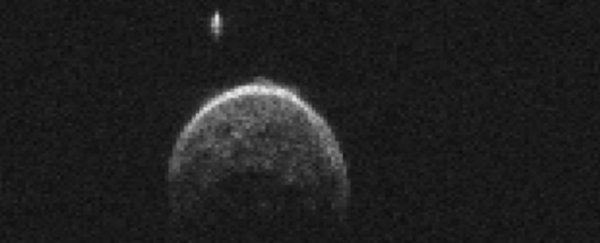Scientists in the US have used NASA's 70-metre-wide Deep Space Network antenna in California to capture the first images of asteroid 2004 BL86, which flew by Earth earlier this week, complete with its own little moon. The asteroid, measures around 325 metres across, and its moon is 70 metres across.
To give you an idea, about 16 percent of asteroids that fly-by Earth are 200 metres across or larger, and are in a binary system, which means they have a moon or a smaller asteroid orbiting it. Some near-Earth objects (NEOs) have even formed triple systems, which means they have two moons orbiting them through space.
The team was able to measure the asteroid and its moon's sizes, shapes, rotation, surface features and roughness by producing radar images as they zoomed past. On Monday, it was about 1.2 million kilometres away from Earth - about 3.1 times the distance between Earth to the Moon -which is the closest it's going to get to us for at least the next 200 years. And we won't see anything this big (that we know of) getting this close to us until asteroid 1999 AN10 flies by in 2027.
According to NASA, as of this week, a total of 12,165 near-Earth objects have been discovered, 868 of which have a diameter of approximately 1 kilometre or larger. Some 1,544 of these NEOs have been classified as Potentially Hazardous Asteroids (PHAs). Next year, NASA plans to launch a robotic probe onto one of the most potentially hazardous PHAs that we know about - asteroid 101955 Bennu. The mission, called OSIRIS-REx, is expected to land the probe in 2018-2019 and return samples of the asteroid to Earth by 2023.
"OSIRIS-REx will survey near-Earth asteroid 101955 Bennu to understand its physical, mineralogical and chemical properties; assess its resource potential; refine the impact hazard; and return a sample to Earth," NASA said in a 2013 press release, when it had selected the spacecraft for the mission. "The spacecraft will rendezvous with the asteroid in 2018. Sample return is planned in 2023. Analysis of the sample returned will reveal the earliest stages of the solar system's evolution and the history of Bennu over the past 4.5 billion years."
Here's what 2004 BL86 looked like as it flew by Earth, with its little companion moon:

